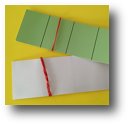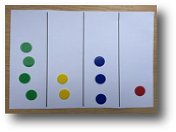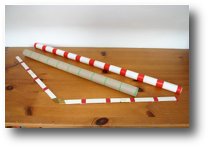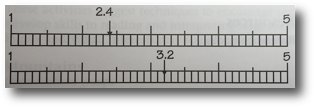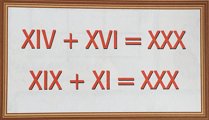Elastic-band strips
Pupils use strips of scrap card which they divide into ten sections.
The bottom left corner of their strips should be marked to show them where to hold it.
Each strip should have an elastic band on it, sufficiently tight that it can be moved along the strip without dropping off. The elastic-band strips need not all be the same size.
- Tell pupils one end of the strip is zero and the other is 1000. Ask them to slide the band to show the positions of 500, 200, 800, 900, ...
- Extend this by asking to be shown the positions of 650, 210, 990, 820. Explain that these positions are approximations.
- Name the ends of the strip zero and 10,000. Ask them to slide the band to show the positions of 5000, 3000, 7000, ...
- Extend this by asking to be shown the positions of 1600, 4800, 3200, 8500, ... . Explain that these positions are approximations.
Mental numbers
Pupils sit with their eyes closed and imagine a number written on the inside of their eyelids.
Imagine this number to be 2346.
Which digit is in the tens column? Which digit is in the ones column?
Which digit is in the hundreds column? Which digit is in the thousands column?
Change over the positions of the 6 and 2. What is the new number?
Make the number one more. What is it now?
Now make this number ten more. What is the new number?
Subtract 100 from the number. What is the number now?
Change the starting number.
Place value mats
Pupils fold a sheet of paper to make a four-column place value mat. They place counters on their mat to represent numbers.
Numbers
Show me 1342, 6193, ...
Show me 2008, 1800, ...
More or less
Show me 4112. Make it 10 more, 100 more, 1000 more.
Show me 2644. Male it 10 less, 100 less, 1000 less.
Limited counters
Use eight counters:
Make the largest/smallest number
Make the number nearest to 5000, 2500, ...
A number with 4 in the hundreds column.
When pupils are confident with using four-digit numbers, repeat the activities for a place value mat with five or six columns. This will introduce ten thousand and hundred thousand, helping to overcome a common error for pupils, thinking that millions follows thousands.
Arrow cards
Each pupil has a set of Arrow cards and combines them to make 4-digit numbers.
Numbers
Show 4256, 1370, ... . Which cards did you use?
Show me a number which has 3, 6, ... in the hundreds column.
Show me a number which has 9, 4, ... in the thousands column.
More or less
Show me 7184. Make it 10 more, 100 more, 1000 more.
Show me 3173. Make it 10 less, 100 less, 1000 less.
Working together
The whole class works together in cooperating groups.
The members of each group make a different number and cooperate to show their response.
Order the numbers.
Who in the group has:
The largest/smallest number
An odd/even number
The number nearest to 5000, 7500, ...
Extend the activities to include ten thousands.
Multiply and divide 3-digit numbers by 10.
Extend to multiplying and dividing by 100.
Digit cards
Use Digit cards 0-9.
Pupils draw four boxes in which to write the digits to make a 4-digit number.
Shuffle the digit cards and choose a card at random. Show it to the pupils and ask them to choose in which of the four boxes to write the digit. The aim is to write digits in the boxes to match a target.
Targets
The largest/smallest number.
The number nearest to 1000.
The largest odd number.
The smallest even number.
Extend the activities to use ten thousands.
My number is...
A pupil thinks of a number. The others take turns to ask a question about it which can only be answered yes or no.
Is your number between 200 and 500? Yes.
Is your number between 200 and 300? No.
Is your number between 300 and 400? Yes.
Is it odd? Yes.
This continues until someone guesses the number, then that pupil ‘thinks of a number’.
Comparing numbers
Introduce the symbols > (greater than) and < (smaller than).
Write on the board 2134 ![]() 2314 and ask for the sign.
2314 and ask for the sign.
Repeat with other pairs of numbers.
Write 6149 < ![]() < 6170 on the board.
< 6170 on the board.
Which numbers could it be?
Compare other numbers in this way, putting a list of 4-digit numbers in order.
Rounding
Explain the rules for rounding numbers. Pupils use arrow cards to show the answer.
Show me 126, 254, 878, ... rounded to the nearest 100.
Show me 1122, 6842, 3586, ... rounded to the nearest 1000.
Calculator constants
Organisation: groups or pairs
Pupils take turns to use the constant +100 by inputting 100++ = and another input, such as 34. The partner predicts what the display will show when the equals key is pressed. This can be repeated for the constant +1000, and for -100 and -1000.
Counting stick
Point to one end of the stick and name it zero and name the other end one.· Starting from zero, move a finger along the stick, a division at a time, and ask which numbers would go there: 0.1, 0.2, 0.3, 0.4, ...
· Point to the halfway position for pupils to see that ½ is equivalent to 0.5.
· Point to random positions on the stick and ask pupils for the appropriate number.
· Extend to hundredths by naming one of the stick zero and the other 0.1. count along the stick: 0.01, 0.02, 0.03. Develop by naming one end, say, 3.1 and the other end 3.2.
Unmarked elastic-band strips
Use unmarked strips of card. The strips can be of almost any size, say about 30cm long by 5cm wide, and need not all be the same size.Tell pupils that one end of the strip is zero and the other end 1.
· Ask pupils to slide the band along the strip to where they think 0.3 is positioned.
· Repeat for different numbers between zero and 1. Explain that the positions are approximate.
Marked elastic-band strips
Pupils use strips of card which they divide into ten sections, with the bottom left corner marked to show them where to hold it. They put an elastic-band onto their strip.Tell pupils one end of the strip is zero and the other end is 1.
Slide the band to show: 0.3, 0.5, 0.8, 0.2, ...
Tell pupils one end of the strip is zero and the other end is ten.
Slide the band to show: 1.5, 7.1, 3.2, ... rounded to the nearest whole number.
Measures
Pupils need practice in reading and interpreting scales and dials as part of their measuring activities. This can include decimal numbers. Discuss the calibrations and scale on a selection of weighing scales and measuring jugs.
Drawing lines
Organisation: individualsPupils use a ruler marked in millimetres to draw lines of a specified length, such as 2.3cm, 6.4cm, ...
Decimal lines
· Pupils draw number lines like these, labelling one end 1 and the other end 5.· Ask pupils to mark positions on the line.
Show me 2.4, 3.7, 1.9, ...
· Ask pupils to describe these in tenths, for example 2 4/10.
The end number can be changed.
A book with 20 pages would have page numbers made from 31 digits (test it to see!)
This book is bigger than that - when the page numbers are added there is a total of 555 digits.
How many pages has this book?
How many of the digits are a 5?
Answer:
221 pages and 42 pages of the book have the digit 5
Each puts a 4-digit number on a calculator, then swap the calculators.
The problem is to try to change one number into the other, one digit at a time.
You change digits by adding or subtracting.

You can change the digit 3 into 0 by subtracting 3000.
Write down the number you put in and the calculation you use.

Be careful! Some addition and subtractions may change more than one digit.
Does it matter in which order you change the digits?




